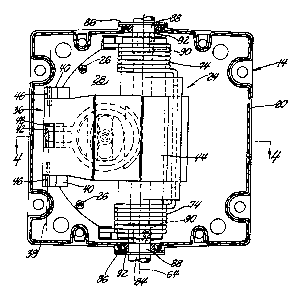Some of the information on this Web page has been provided by external sources. The Government of Canada is not responsible for the accuracy, reliability or currency of the information supplied by external sources. Users wishing to rely upon this information should consult directly with the source of the information. Content provided by external sources is not subject to official languages, privacy and accessibility requirements.
Any discrepancies in the text and image of the Claims and Abstract are due to differing posting times. Text of the Claims and Abstract are posted:
| (12) Patent Application: | (11) CA 2363616 |
|---|---|
| (54) English Title: | FLUID ACTUATOR FOR HINGED VEHICLE SAFETY DEVICES |
| (54) French Title: | ACTIONNEUR HYDRAULIQUE POUR DISPOSITIFS DE SECURITE ARTICULES DE VEHICULES |
| Status: | Deemed Abandoned and Beyond the Period of Reinstatement - Pending Response to Notice of Disregarded Communication |
| (51) International Patent Classification (IPC): |
|
|---|---|
| (72) Inventors : |
|
| (73) Owners : |
|
| (71) Applicants : |
|
| (74) Agent: | SMART & BIGGAR LP |
| (74) Associate agent: | |
| (45) Issued: | |
| (22) Filed Date: | 2001-11-22 |
| (41) Open to Public Inspection: | 2002-09-02 |
| Availability of licence: | N/A |
| Dedicated to the Public: | N/A |
| (25) Language of filing: | English |
| Patent Cooperation Treaty (PCT): | No |
|---|
| (30) Application Priority Data: | ||||||
|---|---|---|---|---|---|---|
|
A fluid actuator attaches a hinged safety device to a vehicle and pivots the
hinged
safety device between retracted and extended positions. The housing of the
actuator has
a base and a removable cover. A sub-assembly is attached to the base. The
subassembly
includes a generally planar base member with integral right cylinder, lever
arm pivot
support and stop posts. A piston slides in the right cylinder and forms a
fluid chamber
between the piston and a closed end of the right cylinder that is fed through
a passage
through the closed end of the cylinder. A lever arm is pivotally attached to
the lever arm
pivot support at one end for pivotal movement between retracted and extended
positions,
the lever arm extending over the cylinder and having a lip at an opposite end
that is
spaced from the right cylinder. A pivot arm engages the top of the piston at
one end and
the lever arm at an opposite end to transfer motion from the piston to the
lever arm. The
lever arm transfers motion to a rotor that is rotationally mounted in the
housing for
movement between retracted and extended positions. The rotor has a spool at
each end
and an eccentric arm between the spools at the respective ends of the rotor
that engages
the lip of the lever arm. A torsion spring encircles each spool with one end
engaging the
rotor and an opposite end engaging a stop post so that the eccentric arm is
biased against
the lip of the lever arm and the rotor and the lever arm are biased to their
respective
retracted positions.
Note: Claims are shown in the official language in which they were submitted.
Note: Descriptions are shown in the official language in which they were submitted.

2024-08-01:As part of the Next Generation Patents (NGP) transition, the Canadian Patents Database (CPD) now contains a more detailed Event History, which replicates the Event Log of our new back-office solution.
Please note that "Inactive:" events refers to events no longer in use in our new back-office solution.
For a clearer understanding of the status of the application/patent presented on this page, the site Disclaimer , as well as the definitions for Patent , Event History , Maintenance Fee and Payment History should be consulted.
| Description | Date |
|---|---|
| Inactive: IPC deactivated | 2011-07-29 |
| Inactive: IPC from MCD | 2010-02-01 |
| Inactive: IPC expired | 2009-01-01 |
| Application Not Reinstated by Deadline | 2007-11-22 |
| Time Limit for Reversal Expired | 2007-11-22 |
| Deemed Abandoned - Failure to Respond to Maintenance Fee Notice | 2006-11-22 |
| Inactive: Abandon-RFE+Late fee unpaid-Correspondence sent | 2006-11-22 |
| Inactive: IPC from MCD | 2006-03-12 |
| Inactive: IPC from MCD | 2006-03-12 |
| Inactive: IPC from MCD | 2006-03-12 |
| Inactive: IPC from MCD | 2006-03-12 |
| Inactive: IPC from MCD | 2006-03-12 |
| Inactive: Cover page published | 2002-09-03 |
| Application Published (Open to Public Inspection) | 2002-09-02 |
| Inactive: First IPC assigned | 2002-01-25 |
| Inactive: IPC assigned | 2002-01-25 |
| Letter Sent | 2001-12-27 |
| Filing Requirements Determined Compliant | 2001-12-27 |
| Application Received - Regular National | 2001-12-27 |
| Inactive: Filing certificate - No RFE (English) | 2001-12-27 |
| Abandonment Date | Reason | Reinstatement Date |
|---|---|---|
| 2006-11-22 |
The last payment was received on 2005-11-02
Note : If the full payment has not been received on or before the date indicated, a further fee may be required which may be one of the following
Please refer to the CIPO Patent Fees web page to see all current fee amounts.
| Fee Type | Anniversary Year | Due Date | Paid Date |
|---|---|---|---|
| Registration of a document | 2001-11-22 | ||
| Application fee - standard | 2001-11-22 | ||
| MF (application, 2nd anniv.) - standard | 02 | 2003-11-24 | 2003-11-03 |
| MF (application, 3rd anniv.) - standard | 03 | 2004-11-22 | 2004-11-03 |
| MF (application, 4th anniv.) - standard | 04 | 2005-11-22 | 2005-11-02 |
Note: Records showing the ownership history in alphabetical order.
| Current Owners on Record |
|---|
| TRANSPEC, INC. |
| Past Owners on Record |
|---|
| JAMES A. HAIGH |
| RICHARD J. IMINSKI |
| RONALD C. LAMPARTER |